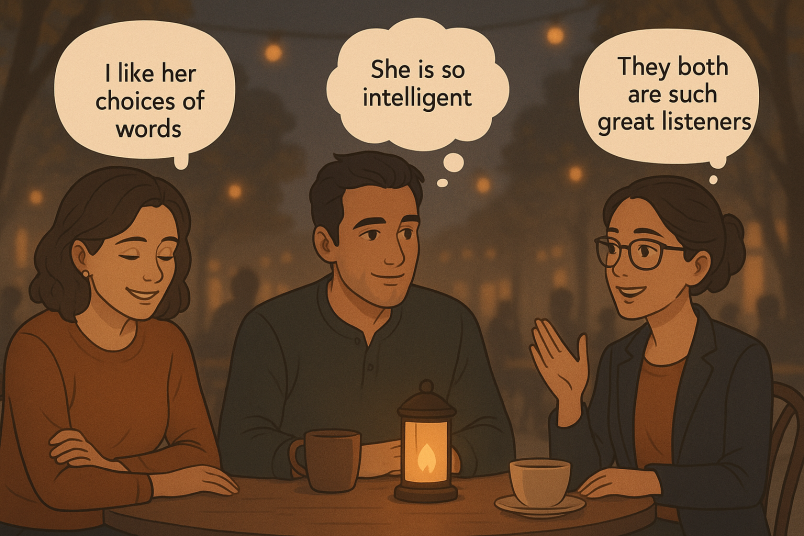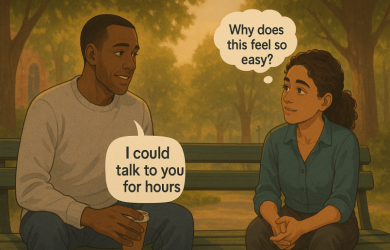What Are the Types of Attraction and How Do They Work?

Unlock Daily 30-Sec Tips for a Happier Relationship
👉 Subscribe FREEKey Takeaways
Marriage.com AI Quick Summary
Attraction can be such a fascinating part of life—it shapes how we connect, bond, and even understand ourselves.
Sometimes it feels simple, like a spark you can’t explain; other times, it’s layered, pulling you toward someone through shared laughter, a kind gesture, or even a deep conversation. We often forget that attraction isn’t just about romance—it can be emotional, intellectual, or even spiritual.
When you pause and think about the many types of attraction, it’s almost like looking at a colorful mosaic; each piece adds meaning, depth, and beauty to the connections that weave through our everyday experiences.
What is attraction?
Attraction is the natural pull or connection you feel toward someone or something—it might be based on appearance, personality, shared values, or simply the way a person makes you feel. It’s a deeply human experience that can show up in different forms and intensity.
A research paper published in Interpersona: An International Journal on Personal Relationships states that interpersonal chemistry is an instant connection shaped by openness, similarity, attraction, warmth, and a unique spark in friendships or romance.
Example: Think about meeting a colleague who makes you laugh effortlessly; you may feel drawn to them, not necessarily romantically, but because their energy uplifts you. That’s a simple example of how attraction can show up in daily life in ways that go beyond the obvious.
5 key factors of attraction
Attraction doesn’t just happen by chance—it often follows certain patterns that psychology has studied for decades. These patterns help explain why we’re drawn to some people more than others.
A research paper published in 2015 states that close relationships—friendships, romantic bonds—are deeply influenced by interpersonal attraction, which is shaped by factors like similarity, familiarity, responsiveness, and how partners exchange rewards and costs.
1. Proximity: the nearness of two people
Being physically close to someone increases the likelihood of developing attraction. When we see or interact with people often, we naturally grow more comfortable around them. Proximity allows trust and familiarity to build, making bonds stronger.
It’s why classmates, co-workers, or neighbors often become friends or more. Research consistently shows that regular contact is a major driver of relationship forming.
- Example: Sitting next to the same person in class every day often leads to friendship or even romantic feelings.
2. Reciprocity: liking someone simply because they like you
We’re more likely to feel attracted to someone when we know they appreciate us. Feeling liked boosts our self-esteem, making us see the other person in a warmer light. This mutual exchange can quickly create strong bonds, since no one wants to feel rejected.
The simple act of someone showing interest often sparks interest in return. That cycle strengthens the connection and makes relationships easier to grow.
- Example: When a friend compliments you often and enjoys your company, you may start liking them even more in return.
3. Similarity: people with many shared traits are attracted to each other
We tend to gravitate toward those who share our values, hobbies, or background. Similarity makes conversations smoother and gives a sense of being understood. It creates common ground, which reduces conflict and increases comfort.
- Example: Two people who both love hiking may form a quick bond after discovering their shared passion.
4. Physical attraction: being drawn to someone based on their good looks
Physical appearance often plays a role in sparking initial interest. People are naturally drawn to traits they find attractive, whether it’s a smile, style, or body language. While looks may catch attention, they don’t guarantee a long-term connection.
An attraction built only on appearance usually fades without emotional or intellectual depth. Still, it often acts as the first step in bringing people closer.
- Example: Noticing someone’s bright smile across a café might make you want to start a conversation with them.
5. Familiarity: seeing the person on a repeated basis
The more we see someone, the more likely we are to feel comfortable around them. Familiarity breeds a sense of safety and predictability, which can naturally grow into attraction. People we see daily often become part of our emotional lives. Over time, familiarity helps turn strangers into trusted companions.
- Example: A coworker you casually greeted for months may gradually become a close friend simply because of repeated interactions.
What are the different types of attraction?
Attraction isn’t just about romance—it comes in many forms that shape how we connect with others. The different types of attraction reveal why we feel drawn emotionally, physically, intellectually, or spiritually, highlighting the unique ways bonds are formed.
1. Aesthetic attraction
Finding someone aesthetically attractive means the person is exceptionally good looking like in the case of a celebrity. Some people might confuse this with physical attraction.
But people who view someone in this category don’t necessarily have a desire to reach out to the person physically or sexually, for that matter.
- Example: Admiring a celebrity’s red-carpet look or a stranger’s stylish outfit without feeling any urge to pursue them romantically or physically.
- How it works: Aesthetic attraction is about appreciating beauty, not necessarily wanting closeness or intimacy.
2. Emotional attraction
You can feel an emotional attachment with numerous people, whether friends, family, or a significant other. These are people with whom you want to be emotionally present, meaning you share your thoughts and feelings on every level.
Maggie Martinez, LCSW, says
We know that emotional connection is usually a necessity for long-lasting relationships.
Experiencing emotional attraction keeps each of these connections, regardless of romantic or otherwise, open, honest, and authentic.
- Example: Talking to your best friend after a tough day because you know they’ll truly understand and support your feelings.
- How it works: Emotional attraction builds trust and intimacy, making relationships stronger and more resilient over time.
3. Sexual attraction
Sexual attraction is the one that most people think of when the word attraction pops up. It’s like seeing someone across a crowded room or running into someone out in public and being drawn to them sexually.
It can be a feeling you get with a partner, and one with whom you realize you want to marry. What makes you sexually attracted to someone will vary for each person.
- Example: Feeling an instant spark of desire when you meet someone at a party and can’t help but notice the chemistry.
- How it works: Sexual attraction is powerful, but it can shift with time, circumstances, and relationship dynamics—it doesn’t always guarantee long-term compatibility.
4. Physical attraction
Physical attraction or sensual attraction is a desire to surround yourself with people who love, respect, and physically handle your needs. While this is typically in a romantic partnership, that isn’t always the case.
Some people we touch in many ways that are not sexual or meant to be romantic, including our kids, friends, or immediate family members.
Please note:
A critical component, as will always be the case, is to communicate to establish the other person’s consent before any physical contact to determine feelings before automatically making your conclusions and having that contact misconstrued.
- Example: Hugging a close friend or holding hands with a partner—moments of closeness that bring comfort and connection without always being sexual.
- How it works: Physical attraction often blends warmth with touch, and it can strengthen bonds in romantic and non-romantic relationships alike.
5. Intellectual attraction
When interacting with others on this level, you find more of a “cerebral” or, perhaps, a mentally attractive connection. That can mean you enjoy spending time with them discussing varied topics, or since the person makes you consider things from fresh, new, and challenging perspectives.
- Example: Enjoying deep conversations with someone who challenges your thinking and broadens your perspective on life.
- How it works:Intellectual attraction often fuels respect and admiration, strengthening connections even when romance or sexuality isn’t part of the relationship.
6. Romantic attraction
A romantically attractive person is entirely different from being sexually attracted to someone, although you could feel each of these for someone. When experiencing a connection of this sort, you want to develop a relationship with the other person.
You could want to have a romance without the element of a sexual component, but it won’t be merely a friendship. The feelings will be on a more profound level than that since you’ll be looking for a romantic partnership with this person.
- Example: Wanting to date someone because you feel emotionally close and imagine building a life together, even without sexual attraction.
- How it works: Romantic attraction centers on partnership and emotional depth—it’s about building commitment, not just passion.
Watch this TED Talk by Terri Orbuch, a sociologist, who shares how lust and love are different—lust fades, love grows through emotional depth, shared identity, and mutual influence.
7. Reciprocal attraction
Reciprocity of attraction is the one of the types of attraction is also referred to as reciprocal “liking,” it is the development of an attraction for someone only after finding out that person has affection or attraction for you.
In other words, “people like those who like them.” This response is rooted in human need for validation and belonging, making it one of the most common types of attraction.
- Example: Developing a crush on a coworker only after learning they admire you first.
- How it works: Reciprocal attraction boosts confidence and creates mutual interest, but it’s important to ensure it grows from a genuine connection and not just validation.
What attracts men vs what attracts women
Attraction often plays out differently for men and women, shaped by biology, psychology, and personal values.
For this point, Maggie adds,
A healthy relationship grows on the basis of authenticity and genuineness from the beginning.
While men may lean toward visual and physical cues, women often focus more on emotional connection, security, and compatibility—though every individual’s experience of different types of attraction is unique.
| Aspect | What women find attractive | What men find attractive |
|---|---|---|
| Confidence | Comfort in yourself; admit weaknesses; laugh at yourself. | Be yourself with healthy self-esteem and play up your best traits. |
| Appearance | Fit look, well-dressed, mindful choices (like ordering wholesome food). | Quirky sides or unique features are appealing and memorable. |
| Interests & Passion | Speak positively about job, hobbies, and life with passion. | Goals, ambition, hobbies show energy and make conversations lively. |
| Authenticity | Genuine personality and openness make women feel secure. | Authentic expression builds trust and keeps men interested. |
| Future Outlook | Likes men who show direction and purpose in life. | Attracted to women with ambition, goals, and vision for the future. |
Please note:
While men and women may be drawn to different qualities, confidence, and authenticity shine through as universal traits. These shared values remind us that genuine connection matters more than perfection.
FAQ
Attraction can be fascinating, yet also a little confusing at times. Here are some quick answers to common questions that bring clarity without overwhelming you.
-
What is the difference between love and attraction?
Attraction is the initial pull or interest you feel toward someone, while love develops over time through trust, emotional bonding, and a deeper connection.
-
Can attraction change over time?
Yes, attraction can grow, fade, or shift depending on shared experiences, personal growth, and changing circumstances in a relationship.
-
Is physical attraction necessary for a healthy relationship?
Not always. While it can play a role, emotional, intellectual, and romantic forms of attraction often matter more for long-term connection and satisfaction.
Essence of attraction
Attraction is a powerful part of human connection, shaping how we build relationships, friendships, and even our sense of self. From the comfort of emotional closeness to the spark of physical appeal, each form plays a unique role in how we relate to others.
Remember, there’s no single right way to experience it—different types of attraction can exist alone or overlap, and all are equally valid. What truly matters is honoring your feelings and building connections that feel safe, genuine, and fulfilling.
 Tips
Tips
Write your tip or submit a video tip
All tips are reviewed before the publishing.
Share this article on
Want to have a happier, healthier marriage?
If you feel disconnected or frustrated about the state of your marriage but want to avoid separation and/or divorce, the marriage.com course meant for married couples is an excellent resource to help you overcome the most challenging aspects of being married.
Recent Articles
Related Quizzes
Unlock Daily 30-Sec Tips for a Happier, Healthier Relationship
👉 Subscribe FREE on YouTube We'd love your feedback!
We'd love your feedback!
 Expert Q&A
Expert Q&A
Ask your question related to this topic & get the support you deserve from experts.





















 Thanks for your feedback!
Thanks for your feedback!